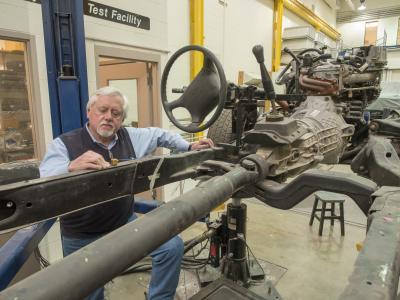It's a sci-fi concept that's at the center of a 25-year exploratory project: building a hypersonic aircraft that takes off from the runway and doesn't need a rest, inspection or repair after it lands – unlike the space shuttle – but can zip back around the world within an hour's landing. University of Cincinnati researchers are developing the validation metrics that could help predict the success or failure of such a model before it is even built, as test data becomes available from component, to sub-system, to the completely assembled air vehicle.
That's among the UC research that will be presented from around the world at IMAC XXXII: A Conference and Exposition on Structural Dynamics. The conference takes place Feb. 3-6 in Orlando, Fl.
Randy Allemang, a UC professor of mechanical engineering and director of the Structural Dynamics Research Lab in the UC College of Engineering and Applied Science (CEAS), will present a validation metric that involves principal component analysis (PCA) decomposition of simulation and test data to measure the uncertainty in how well the models match with measured data, which will ultimately determine the success in approaching how such a plane could be built. That 25-year exploratory project is led by the U.S. Air Force.
"The very early stages of testing examine the concept of a plane that would fly as much as 10 times the speed of sound, with Mach 5 being the starting point," says Allemang. "In order to be ready to build that airplane, there is a lot of technology that will need to improve over the next 20 years, and there aren't the resources to do the prototype testing like what was done in the space race of the '50s and '60s. Back then, there wasn't the ability to do a lot of analysis, so during testing, there were a lot of failures, and it was very expensive. So, we need to improve analytical capabilities to better predict what could happen."

Professor Randy Allemang is shown in the Structural Dynamics Research Lab.
(Photo Credit: Jay Yocis)
Allemang says the validation metric is showing considerable promise. The testing involved four comparisons of 500-by-146 pieces of information in its datasets to develop the validation metric. Allemang explains that in comparing the two sets of data, the researchers expect their actual measurement to be less than what they predicted, and they wanted the uncertainty to be smaller than the distance away from the prediction. The validation metric was evaluated using test data acquired on a car, using the four-axis road simulator in the UC Department of Mechanical Engineering's Structural Dynamics Research Laboratory – a leader in experimental modal analysis and structural dynamics.
"People do these comparisons and predictions in a number of areas – the nuclear industry, in ground water penetration, in weather prediction – they come up with a way to quantify something that has a very large number of parameters that could be used to describe it," says Allemang, who adds that the primary advantage of the PCA validation metric is that quantifications of margin and uncertainty can be made in engineering units. The method condenses a large amount of data and it can be used over a wide range of temporal information as well as over a wide variety of measured quantities.
Allemang says further testing of the PCA validation metric is expected to be conducted on an aircraft panel later this year by the Structural Sciences Center at the Air Force research labs at Wright-Patterson Air Force Base.
Source: University of Cincinnati